Seychelles undertaking breadfruit census for improved food security
General |Author: Salifa Karapetyan Edited by: Betymie Bonnelame | April 25, 2022, Monday @ 11:42| 12254 views
The fruit, known locally as friyapen, has a tough green outer skin and a white or yellow potato-like inner texture. (Gerard Larose)
As part of a regional project to conserve biodiversity and make use of crop genetic resources, Seychelles is carrying out a survey on its three main islands to quantify the number of breadfruit trees in the country.
Dubbed "Germination," the project is geared towards improving food security in countries of the Indian Ocean, namely Seychelles, Comoros, Madagascar, Mauritius, Reunion, and Tanzania.
The principal agricultural scientist at the Anse Boileau Research Centre, Roy Govinden, told SNA that Seychelles is putting emphasis on breadfruit as it is an undervalued source of carbohydrate that grows in abundance in the country.
"Being a country that imports a lot of the food that we consume, we are quite vulnerable to external shocks as past events have shown us. Should a situation arise where importation of food into the country cannot be maintained, breadfruit is something we can fall back on," said Govinden.
After completing an inventory on La Digue, the Seychelles Agricultural Agency (SAA) established a population of 311 breadfruit trees on the third most populated island of the island nation. Some areas on the main island of Mahe and the second most populated island of Praslin remain to be covered. The districts found with the largest number of trees are Anse Aux Pins, Anse Royale and Baie Lazare.
"There is a large population of breadfruit in the country but many are not accessible. The trees that we are seeing are quite high and not manageable and as such fruits cannot be harvested," said Govinden.
 |
| An inventory on La Digue has shown that there is a population of 311 breadfruit trees on that island. (Gerard Larose) Photo License: CC-BY |
Seychelles, an archipelago in the western Indian Ocean, also seeks to establish the different varieties of breadfruits to make better use of the fruit based on what they are best suited for.
"At the moment, we have been able to identify two or three varieties - there are breadfruits that are rounder and some tend to be longer, and the colour of the inside of the flesh varies, one is whiter while another has a yellow tint to it. When we get to the categorising stage, we will be better able to identify them," shared Govinden.
Once the census is completed the agency will redirect its efforts towards educating the population on how to properly trim and manage their breadfruit trees to ensure that fruits can be collected in higher yields.
"There will also be a need to emphasise valorising breadfruits. We will have to educate the population on its benefits, and how to add value to the product," said Govinden.
Along with cassava, breadfruit used to be a popular and traditional staple food in Seychelles in the years before the regular importation of other staples such as rice, potatoes and bread flour.
The fruit, known locally as friyapen, has a tough green outer skin and a white or yellow potato-like inner texture and can be boiled, grilled, fried, steamed, roasted or more popular eaten cooked in coconut milk called la daube as a dessert.
Govinden shared that there is the possibility to turn the fruit into flour which can also be used to make various food products.
Back
